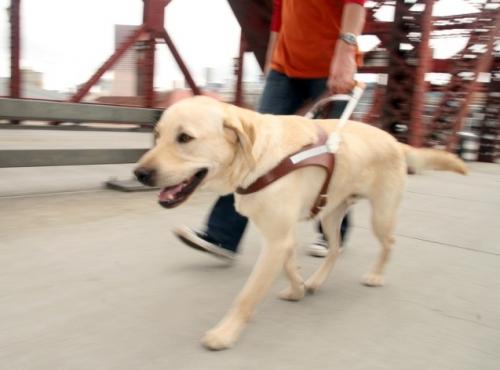Dogs, by and large, are amazing creatures. But official dogs, such as guide dogs, stand out significantly among all pets. In addition to the traditional canine devotion, they play an important role in the life of visually impaired people.

When dogs were first used as guide dogs?
Contents
Guide dogs for the blind and visually impaired have an impressive a story that began in Germany during the First World War, where service dogs were the first to help vision impaired veterans in battles. Guide dogs came to fame in 1927, when American dog breeder, Dorothy Harrison Eustis, wrote an article guide dogs to the Saturday Evening Post. Her article inspired a visually impaired American named Morris Frank.
Frank visited Switzerland and trained there Buddy, one of the Justis dogs. After that, Frank and Buddy returned to the United States, where they committed big tour demonstrating the ability of guide dogs. Them public speaking showed the need for official access dogs to shops, restaurants, hotels, public transport and to other places where they were previously denied access. They also founded The first school of guide dogs in America.
Which breeds are suitable as a guide?
Initially, the most common service dog was a German shepherd, but today many breeds can become guide dogs. Coaches acknowledge that the Golden Retriever, Labradors, poodles, collies, boxers, rottweilers, airedale, doberman and some other suitable breed sizes become enough good guide dogs. Size matters because the height of the dog should fit its owner.
The most popular guide dog today is Labrador Retriever, as she has a short coat, various size and moderate. Guide dog does not need excellent pedigree, other breeds such as the Golden Retriever, or a cross between a Labrador will also be really good assistants. Poodles and crosses of Labradors have a weak molt, which makes them also a good choice for people suffering from allergies.
How are guide dogs trained?
Guide dogs are taught at puppy schools in some schools. Puppies are excommunicated and given to the family, where they are socialized and get used to family life.
At about the age of 12-18 months, dogs return to school, where do they study. The first 4-5 months, training takes place with experienced trainer. Last month, training is also under coach’s guidance, but with a blind or visually impaired a man who will become his companion and new best friend.
Both the dog and its owner are trained at the school. Dog learns to “lead” person. Man learns to handle, communicate and care for the dog. Close relationships develop during this process. and the deep connection between the dog and its owner.
The dog is taught to navigate various obstacles, but she never become a “leader.” Man is taught to guide the dog and use the different teams learned by the dog at school. Other in a word, a dog is a car driver who discovers obstacles and go around them.
What skills do guide dogs get?
Guide dogs must be able to safely lead a person into indicated place. This requires them to detect possible dangers both below and above. Low branches or lines power lines, curbs, stairs and potholes can be a disaster for a blind person.
In addition to owner commands, guide dogs learn to reason. If a person gives the command to cross the street when cars are approaching, the dog learns not to obey. This ability is called smart disobedience and is crucial for the safety of both man and animal.
Dogs also learn to ignore distracting objects that may interfere with their duties. These amazing dogs have real willpower so as not to chase a random ball and not forget about your owner.
Etiquette training is an important part of schooling. To attend various public places, such as restaurants or shops, good manners are required.
Guide dogs are really smart animals, but there are some things they just can’t do. They can not understand the traffic signals that the owner must know in order to understand when you can cross a pedestrian crossing. Some intersections have beeps that help with this. And although dogs have good instincts to navigate the terrain, they don’t can chart a route in unfamiliar places. Dog abilities and human when they work together make them much more successful to navigate the street.
What are the benefits of service dogs?
Dog lovers can fully experience the dog’s benefits in family. Medical studies show dogs are positive affect the health of their owners. Dogs also give positive psychological effect that makes a person more confident and allows you to feel safe. Blind people with guide dogs have more opportunities to recognize and communicate with the outside world.
A companion dog also relieves depression, stress and anxiety, which improves the cardiovascular system. Also blind the guide man is likely to walk more and perform additional exercises to improve health. People on the street are more likely to communicate with a person walking with a dog, therefore, the visually impaired owner of the guide dog uses more active social interaction.
In general, a guide dog is not just a service animal, it also a true friend. Good character and right training makes dogs loyal to owners and happy on work! Thanks to Buddy and Frank, many people with disabilities today view with pleasure walking on the street with their guide dogs!






